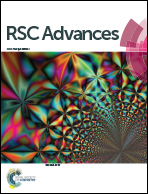Mesoporous graphitic carbon nitride functionalized iron oxides for promoting phenol oxidation activity†
Abstract
Mesoporous graphitic carbon nitride was found to be a superior support of iron oxides, improving the dispersion, adjusting the iron oxidation state, and promoting the catalytic oxidation of phenol. The physicochemical characteristics of the as-prepared FeOx/g-C3N4 were evaluated by XRD, FT-IR, TEM, N2 sorption and XPS, which together revealed the influence of the g-C3N4 support on the physicochemical properties of FeOx. The catalytic activity was evaluated by phenol oxidation reaction under ambient condition. Importantly, FeOx are highly dispersed and due to the large SBET and the support's amino group's adjusting the crystallization process of Fe(III). The carbon nitride supported catalyst attained 80% conversion in 30 minutes for phenol oxidation under equivalent conditions to which a SBA-15 supported Fe catalyst only achieved 3% conversion within 60 minutes. We speculate that the partial pyrolysis of g-C3N4 leads to the formation of carbon and nitride fragments that alter the redox properties during the formation of FeOx, therefore, producing more Fe(II) species, which contributes to enhanced Fenton activity. The strategy of using mesoporous g-C3N4 as a support is a reliable method for preparing highly dispersed transition metal oxides with adjustable physicochemical state.


 Please wait while we load your content...
Please wait while we load your content...